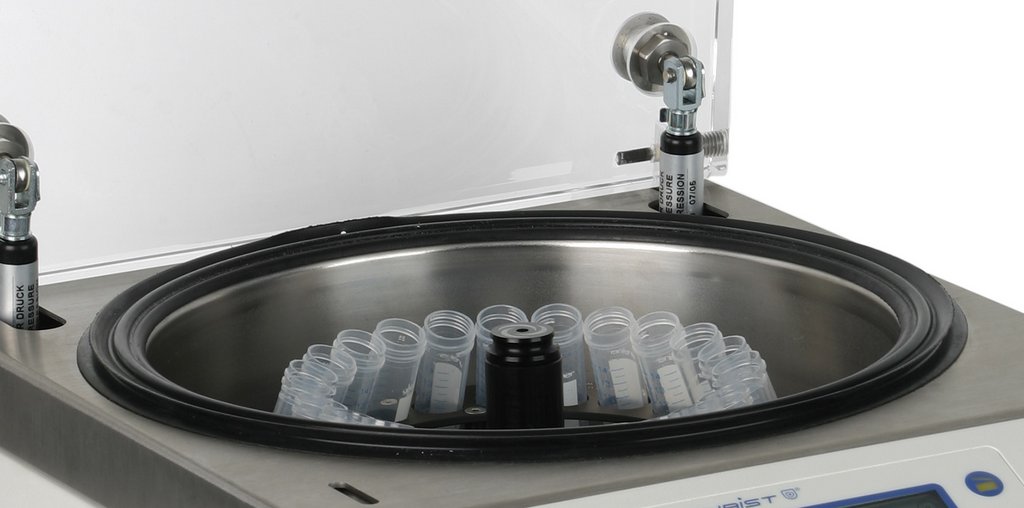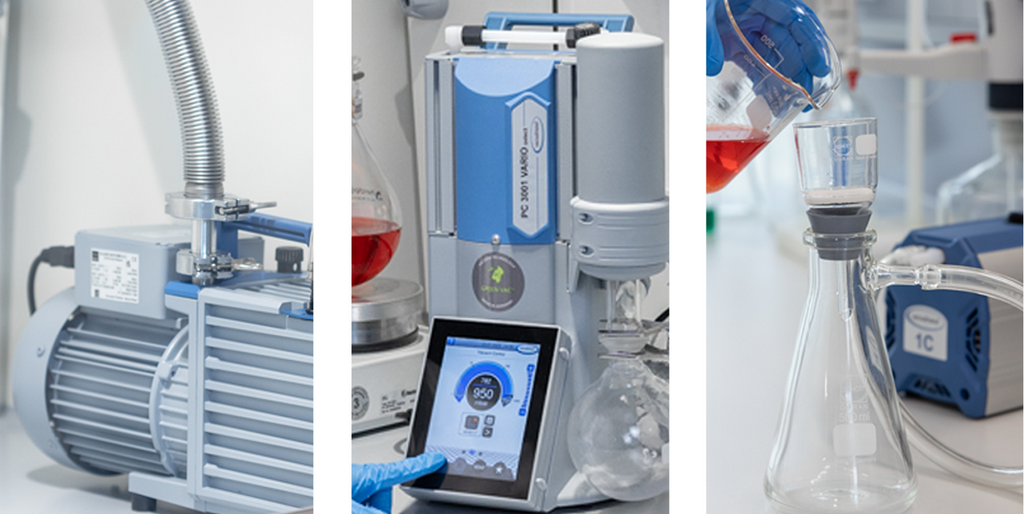Vacuum Concentration
Vacuum concentration is a crucial technique in laboratory sample preparation, allowing for efficient solvent removal while preserving sample integrity. The concentration process is widely used in research and industry applications where precision and reproducibility are essential. Selecting the right vacuum pump and system ensures optimal evaporation control, preventing sample loss and improving overall lab efficiency.
What is Vacuum Concentration?
Vacuum concentration is a laboratory technique used to remove solvents from samples through controlled evaporation. By applying vacuum pressure, the boiling point of the solvent is lowered, allowing for efficient solvent removal at reduced temperatures. This method is widely used in applications where preserving sample integrity is critical, as it minimizes thermal degradation and enhances reproducibility.
Why is Vacuum Concentration Important?
Proper vacuum concentration ensures accurate and reproducible results by preventing common issues such as sample bumping, cross-contamination, and incomplete evaporation. The right vacuum system maintains precise control over pressure, heat transmission, and solvent recovery, optimizing laboratory efficiency and ensuring high-quality outcomes. Cold traps are often incorporated into vacuum concentrator systems to condense and collect volatile organic solvents, preventing contamination, increasing pump efficiency, and extending pump lifespan.

Process Requirements for Effective Vacuum Concentration
The Role of Vacuum Control in Sample Concentration
The efficiency of a vacuum concentrator, or vacuum centrifuge, depends on its ability to maintain the appropriate vacuum level throughout the evaporation process. Insufficient vacuum control can lead to inconsistent evaporation rates, prolonged processing times, or sample bumping, which can result in cross-contamination or loss of sample material.
- Optimized Vacuum Depth: Different sample types require varying vacuum levels to achieve efficient evaporation without boiling over.
- Controlled Evaporation Rate: Maintaining an optimal balance between pressure and temperature prevents unwanted sample degradation.
- Prevention of Sample Loss: Proper vacuum regulation minimizes the risk of splashing or foaming during solvent removal.
- Optimum Heat Transmission: Efficient heat transfer to sample vessels enhances evaporation efficiency and uniformity.
- Medium to High Vacuum Requirements: Ensuring proper vacuum depth for different sample types and solvent compositions.
- Fast and Highly Sensitive Vacuum Control: Essential for handling samples that tend to foam, preventing loss and contamination.
- Control of Condensate and Droplet Precipitation: Managing condensate buildup between the pump and concentrator improves system performance and longevity.
Addressing Common Challenges in Vacuum Concentration
Laboratories frequently encounter issues such as solvent bumping, incomplete evaporation, and material cross-contamination. These challenges can be mitigated by:
- Implementing gradual vacuum ramping to prevent sudden pressure drops that cause bubbling.
- Using adaptive vacuum control to adjust pressure in real time based on solvent properties.
- Selecting chemically resistant pumps to handle aggressive solvents without degradation.
Pump Requirements for Vacuum Concentrators
Selecting the Right Vacuum Pump
Vacuum pumps are the backbone of vacuum concentrator systems, creating and maintaining the necessary vacuum level to facilitate efficient solvent removal. Selecting the right pump enhances concentration speed, prevents sample loss, and ensures reproducible results.
When choosing a vacuum pump for a specific concentrator application, several factors must be considered to ensure optimal performance:

- Chemical Compatibility: The pump must be resistant to the solvents and chemicals used in the process to prevent degradation and ensure long-term reliability.
- Flow Rate & Throughput: A sufficient volume flow rate (2 m³/h and more) is necessary to remove vapors effectively, influencing the speed of solvent evaporation.
- Precise Vacuum Control: Maintaining the correct vacuum pressure prevents sample bumping and ensures consistent concentration, especially for sensitive liquid samples
- Condensate Tolerance & Protection: Pumps should include features like vacuum inlet separators (AK) to protect against liquid droplets and emission condensers for solvent recovery, reducing environmental impact.
Comparing Pump Technologies: Fixed-Speed vs. Variable-Speed Pumps
Vacuum pumps used in concentrators generally fall into two categories: fixed-speed pumps and variable-speed pumps. Fixed-speed pumps, or single-speed pumps, operate at a constant vacuum level, maintaining stable conditions suitable for applications requiring consistent pressure. In contrast, variable-speed pumps dynamically adjust vacuum levels based on process demands, optimizing solvent removal efficiency and preventing sample bumping.
Recommended Solutions
To meet the diverse needs of laboratory vacuum concentration, BRANDTECH offers a range of high-performance VACUUBRAND pumps designed for precision and efficiency.
VACUUBRAND vacuum pumps available from BRANDTECH Scientific are engineered to meet the demands of vacuum concentrators, ensuring precision, efficiency, and durability.
Applications of Vacuum Concentration
Life Sciences Research
Vacuum concentrators are widely used in molecular biology and proteomics for concentrating DNA, RNA, and proteins. The ability to remove solvents without damaging biomolecules is critical for achieving reproducible results. In these applications, a variable-speed pump is preferred to precisely control vacuum levels and prevent sample degradation.
Pharmaceutical Development
In drug formulation and compound screening, vacuum concentrators enable precise solvent removal, aiding in the preparation of active pharmaceutical ingredients (APIs) and enhancing sample stability. A variable-speed pump is ideal in pharmaceutical applications to optimize evaporation rates for different solvents and formulations.
Environmental & Food Science
Vacuum concentration is instrumental in sample preparation for residue analysis, contaminant detection, and food component extraction. Laboratories rely on vacuum concentrators to achieve high-precision results in environmental monitoring and quality control testing. Depending on the sample type, both fixed-speed and variable-speed pumps can be used, with variable-speed pumps offering greater flexibility for handling diverse solvents.




